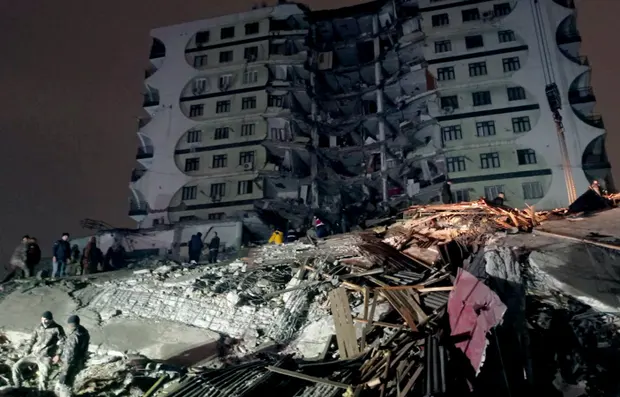Hundreds of people have been killed as they slept in Turkey and Syria after a 7.8-magnitude earthquake hit in the early hours of Monday morning, in one of the most powerful quakes in the region in at least a century.
Thousands more were injured as the quake wiped out entire sections of major cities in a region filled with millions of people who have fled the civil war in Syria and other conflicts.
By 9am GMT the death toll had been put at 237 in government-controlled parts of Syria, 147 in rebel-held northern Syria and 284 in Turkey.
The quake struck at 4.17am local time (1.17am GMT) at a depth of about 17.9km (11 miles) near the Turkish city of Gaziantep, which is home to about 2 million people, the US Geological Survey said. Turkey’s Afad emergencies service centre put the first quake’s magnitude at 7.4, adding that it was followed by more than 40 aftershocks.
Television images showed shocked people in Turkey standing in the snow in their pyjamas, watching rescuers dig through the debris of damaged homes. Buildings were levelled while many people were still asleep.
The number of confirmed casualties rose rapidly on Monday morning as rescue teams rushed to find survivors. Tremors were felt as far away as Lebanon, Greece, Israel and the island of Cyprus.
The head of the Turkish Red Crescent, the biggest humanitarian organisation in Turkey and part of the International Red Cross, said it was mobilising resources for the region and urged people to evacuate damaged homes.
Images on Turkish television showed rescuers digging through the rubble of levelled buildings in the city of Kahramanmaraş and neighbouring Gaziantep, where entire sections of cities were destroyed. A fire lit up the night sky in one image from Kahramanmaraş, although its origin remained unclear.
Buildings also crumbled in the cities of Adıyaman, Malatya and Diyarbakır, where panicked people rushed out on the street.
Residents in the town of Pazarcık said they feared for those trapped under fallen buildings. Nihat Altundağ said the powerful shocks from the earthquake woke his family.
“Our house looks solid from the outside but there are cracks inside. There are destroyed buildings around me, there are houses on fire, there are buildings that are cracking. A building collapsed just 200m away from where I am now,” he said. “We are waiting for the sun to rise so that we can see the scale of the earthquake. People are all outside, all in fear.”
“Pazarcık is in ruins,” said another resident, Hüseyin Satı. “The building where I live is not so tall, and was built in compliance with earthquake regulations, so it didn’t collapse. But still there are cracks on the walls. A neighbour of mine broke his back while jumping from the balcony during the earthquake and is now in hospital.”
Satı said civilians were desperately trying to help dig their neighbours out from under collapsed buildings. “Two of my friends are under the rubble now, we are trying to reach them,” he said.
The Turkish president, Recep Tayyip Erdoğan, who will be under pressure to oversee an effective response to the disaster heading to a tightly contested election on 14 May, said search and rescue teams had been dispatched to the affected areas. “We hope to get through this together as soon as possible and with the least damage, and we continue our work,” he tweeted.
The Syrian health ministry reported damage across the provinces of Aleppo, Latakia, Hama and Tartus, where Russia is leasing a naval facility.
Even before the tragedy, buildings in Aleppo, Syria’s prewar commercial hub, often collapsed due to the dilapidated infrastructure after more than a decade of war as well as little oversight to ensure safety of new construction projects, some built illegally.
The Syrian Civil Defence, a rescue service known as the White Helmets that works to save those trapped under debris from airstrikes, said they had declared a state of emergency to rescue the many people feared trapped under collapsed buildings in areas around Idlib across opposition-held areas in north-western Syria.
In a statement, the organisation described “a catastrophic situation with buildings collapsed or suffering major cracks, hundreds injured and stranded, dozens dead and a lack of services as well as safe shelters and assembly points in stormy and snowy weather conditions and low temperatures”.
The group also added a plea for aid from the international community “to prevent the situation from worsening” and to pressure both the Syrian government and their backers in Moscow to hold back on airstrikes in the area to prevent further tragedy.
People in Damascus, as well as in the Lebanese cities of Beirut and Tripoli, ran into the street on foot and took to their cars to get away from their buildings in case of collapses, witnesses said.
“Paintings fell off the walls in the house,” said Samer, a resident of Damascus, the Syrian capital. “I woke up terrified. Now we’re all dressed and standing at the door.”
Turkey is in one of the world’s most active earthquake zones, with land stretching over the Anatolian fault line in the north of the country that has caused large and destructive tremors. İzmit and the surrounding Kocaeli region, close to Istanbul, was rocked by a 7.4-magnitude earthquake in 1999, the worst to hit Turkey in decades.
The quake killed over 17,000 people, including at least 1,000 in Istanbul, amid widespread destruction.
Experts have long warned a large quake could devastate Istanbul, which has allowed widespread building without safety precautions.
Naci Görür, an earthquake expert with Turkey’s Academy of Sciences, urged local officials to immediately check the region’s dams for cracks to avert potentially catastrophic flooding.



